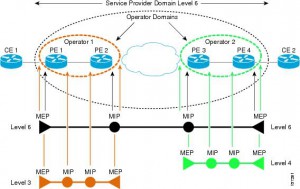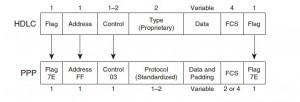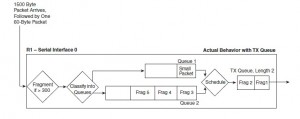Different RD values for different sites – mandatory.
neighbor <address> internal-vpn-client
neighbor <address> route-reflector-clinet
neighbor <address> next-hop-self
NHS – mandatory.
ATTR_SET – new BGP attribute, which “embeds” CE BGP attributes. CE attributes are transparent for VPN backbone. VPN backbone attributes are not passed to CE.
The ATTR_SET attribute has this format:
+------------------------------+
| Attr Flags (O|T) Code = 128 |
+------------------------------+
| Attr. Length (1 or 2 octets) |
+------------------------------+
| Origin AS (4 octets) |
+------------------------------+
| Path Attributes (variable) |
+------------------------------+
The attribute flags are the regular BGP attribute flags (refer to RFC 4271). The attribute length indicates whether the attribute length is one or two octets. The purpose of the Origin AS field is to prevent the leak of one route originated in one AS to be leaked to another AS without the proper manipulation of the AS_PATH. The variable length Path Attributes field carries the VPN BGP attributes that must be carried across the SP core.
When PE1 receives the BGP prefix 10.100.1.1/32 from CE1, it stores it twice:
PE1#show bgp vpnv4 unicast all 10.100.1.1/32
BGP routing table entry for 65000:1:10.100.1.1/32, version 21
Paths: (2 available, best #1, table customer1)
Advertised to update-groups:
5
Refresh Epoch 1
Local, (Received from ibgp-pece RR-client)
10.1.1.4 (via vrf customer1) from 10.1.1.4 (10.100.1.1)
Origin IGP, metric 0, localpref 200, valid, internal, best
mpls labels in/out 18/nolabel
rx pathid: 0, tx pathid: 0x0
Refresh Epoch 1
Local, (Received from ibgp-pece RR-client), (ibgp sourced)
10.1.1.4 (via vrf customer1) from 10.1.1.4 (10.100.1.1)
Origin IGP, localpref 100, valid, internal
Extended Community: RT:1:1
mpls labels in/out 18/nolabel
rx pathid: 0, tx pathid: 0
The first path is the actual path on PE1, because it is received from CE1.
The second path is the path that is advertised towards the RRs/PE routers. It is marked with ibgp sourced. It contains the ATTR_SET attribute. Notice that this path has one or more Route Targets (RTs) attached to it.
PE1 advertises the prefix as shown here:
PE1#show bgp vpnv4 unicast all neighbors 192.168.100.3 advertised-routes
BGP table version is 7, local router ID is 192.168.100.1
Status codes: s suppressed, d damped, h history, * valid, > best, i - internal,
r RIB-failure, S Stale, m multipath, b backup-path, f RT-Filter,
x best-external, a additional-path, c RIB-compressed,
Origin codes: i - IGP, e - EGP, ? - incomplete
RPKI validation codes: V valid, I invalid, N Not found
Network Next Hop Metric LocPrf Weight Path
Route Distinguisher: 65000:1 (default for vrf customer1)
*>i 10.100.1.1/32 10.1.1.4 0 200 0 i
Total number of prefixes 1
This is how the RR sees the path:
RR#show bgp vpnv4 un all 10.100.1.1/32
BGP routing table entry for 65000:1:10.100.1.1/32, version 10
Paths: (1 available, best #1, no table)
Advertised to update-groups:
3
Refresh Epoch 1
Local, (Received from a RR-client)
192.168.100.1 (metric 11) (via default) from 192.168.100.1 (192.168.100.1)
Origin IGP, localpref 100, valid, internal, best
Extended Community: RT:1:1
Originator: 10.100.1.1, Cluster list: 192.168.100.1
ATTR_SET Attribute:
Originator AS 65000
Origin IGP
Aspath
Med 0
LocalPref 200
Cluster list
192.168.100.1,
Originator 10.100.1.1
mpls labels in/out nolabel/18
rx pathid: 0, tx pathid: 0x0
Notice that the local preference of this VPNv4 unicast prefix in the core is 100. In the ATTR_SET, the original local preference of 200 is stored. However, this is transparent to the RR in the SP core.
On PE2, you see the prefix as shown here:
PE2#show bgp vpnv4 unicast all 10.100.1.1/32
BGP routing table entry for 65000:1:10.100.1.1/32, version 5
Paths: (1 available, best #1, no table)
Not advertised to any peer
Refresh Epoch 2
Local
192.168.100.1 (metric 21) (via default) from 192.168.100.3 (192.168.100.3)
Origin IGP, localpref 100, valid, internal, best
Extended Community: RT:1:1
Originator: 10.100.1.1, Cluster list: 192.168.100.3, 192.168.100.1
ATTR_SET Attribute:
Originator AS 65000
Origin IGP
Aspath
Med 0
LocalPref 200
Cluster list
192.168.100.1,
Originator 10.100.1.1
mpls labels in/out nolabel/18
rx pathid: 0, tx pathid: 0x0
BGP routing table entry for 65000:2:10.100.1.1/32, version 6
Paths: (1 available, best #1, table customer1)
Advertised to update-groups:
1
Refresh Epoch 2
Local, imported path from 65000:1:10.100.1.1/32 (global)
192.168.100.1 (metric 21) (via default) from 192.168.100.3 (192.168.100.3)
Origin IGP, metric 0, localpref 200, valid, internal, best
Originator AS(ibgp-pece): 65000
Originator: 10.100.1.1, Cluster list: 192.168.100.1
mpls labels in/out nolabel/18
rx pathid:0, tx pathid: 0x0
The first path is the one received from the RR, with the ATTR_SET. Note that the RD is 65000:1, the origin RD. The second path is the imported path from the VRF table with RD 65000:1. The ATTR_SET has been removed.
This is the path as seen on CE2:
CE2#show bgp ipv4 unicast 10.100.1.1/32
BGP routing table entry for 10.100.1.1/32, version 10
Paths: (1 available, best #1, table default)
Not advertised to any peer
Refresh Epoch 1
Local
10.1.2.2 from 10.1.2.2 (192.168.100.2)
Origin IGP, metric 0, localpref 200, valid, internal, best
Originator: 10.100.1.1, Cluster list: 192.168.100.2, 192.168.100.1
rx pathid: 0, tx pathid: 0x0
Notice that the next-hop is 10.1.2.2, which is PE2. The cluster list contains routers PE1 and PE2. These are the RRs that matter inside the VPN. The SP RR (10.100.1.3) is not in the cluster list.
The local preference of 200 has been preserved inside the VPN across the SP network.





